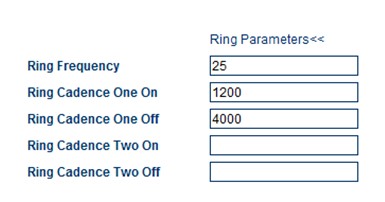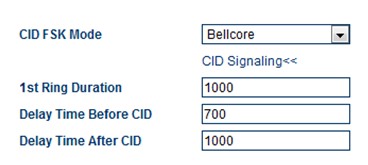
FAQ & Solutions
FAQHome > FAQ
A. FAQ on FXS gateways
1. Can extension lines in our FXS gateways with multiple lines call each other when it is configured as Single Server Mode?
In Single Server mode, all extension lines shares the same SIP number. Therefore, they cannot call each other. Config. By Line or Config. By Group mode should be used so that each extension line or each group has its own SIP number. In this case, calling between extension lines or groups can then be achieved.
2. Can our FXS gateway work with all types of PSTN phones?
Not all PSTN phones work properly with our FXS gateways with the default telephone line interface settings. You may need to modify the following parameters via its built-in webpages.
a) Telephone Line Voltage - Most PSTN phones nowadays works with telephone line voltage of 48 Volts. This parameter should be enabled as shown below. If the line voltage is not configured properly, DTMF dialing may be affected as well.

b) Ringing settings - Some PSTN phones may be designed to work with certain ringing frequency and pattern. Modified these parameters shown below accordingly. Please note that the default ringing voltage is 48Volts sine wave without DC offset. Our old FXS hardware only support 48Volts square wave without DC offset. If your PSTN phone does not work because it requires higher ringing voltage or different ringing waveform, it is not compatible with our FXS gateway. Please use a different PSTN phone. 

c) CID Settings - These parameter defines how CID / CLI signals are generated. Please note that only FSK based CID signals are supported. If your PSTN phone only support DTMF CID, it will not be able to display the CID of the caller. You will not to replace it with a PSTN phone that can support FSK CID signals if this CID feature is required.
CID FSK Mode defines whether the Bellcore or the ETSI FSK frequencies to be used. In the Bellcore standard, the Mark ("1") and Space ("0") frequencies are 1200 Hz and 2200 Hz. In the ETSI standard, they are 1300 Hz and 2100 Hz.
Not all CID call setup and timing parameters are support. Our FXS port only support CID signals with the call setup using 1st Ring. The duration of the first can be specified. In addition, the delay time between the end of the first ring and the generation of the CID signal can also be defined as Delay Time Before CID. The last parameter, Delay Time After CID, defines the silent period before normal ringing starts.

3. Does our FSX gateway support line reverse polarity?
Line reverse polarity is implemented on our FXS port when the called party answers a call. Some systems may require this line reversal as an indication to start counting the talk time for billing.
4. Is FAX supported?
Only models HT-912T and HT-922T support T.38 and G.711 Fax mode.
5. Is VPN supported?
PPTP VPN with 40-bit encryption is supported. Please make sure your VPN server is configured for 40-bit encryption.
The latest models HT-912T and HT-922T are already VPN supported. For earlier models, please upgrade firmware to version 31.5-15 via the link below.
6. The RUN LED does not flash and the Line LED does not turn on when picking the PSTN phone connected.
The FXS gateway is damaged. Please return it for repairs.
7. No voice is heard when picking up the phone
Please make sure that the power adapter is properly connected to the FXS gateway. If the power is connected, the RUN LED should blinks. If not, the hardware is damaged. Please return it for repairs.
If the RUN LED blinks, the Line LED should light up. If not, please check to see if the phone is plugged to the correct phone jack. Please make sure that the PSTN phone is working. If the Line LED still does not light up, the hardware is likely damaged, please return it for repairs.
8. What do you see from the LEDs and hear from the receiver of the phone when SIP registration fails?
If SIP registration fails, you will see that the RUN LED blinks at a fast rate and hears an abnormal tone (not a normal dial tone) from the phone receiver.
B. FAQ on GoIP gateways
1.What is a GoIP?
GoIP is the short name for GSM Gateway of VoIP. It is intended to bridge VoIP calls to GSM and GSM calls to VoIP. It is similar to a FXO gateway except that it is using the GSM network instead of the traditional PSTN network.
2.What are the advantages of GoIP over FXO gateways?
In principle, GoIP can achieve all the functions that an FXO gateway can do with additional values listed below.
a)With GSM costs getting lower and lower in many countries, it make more sense to use GSM for call termination rather than traditional PSTN lines. With GSM, there are no expensive charges and long waiting period for installation/reallocation.
b)You can change the phone and service provider by just changing the SIM card.
c)Text messaging via GSM SMS is powerful for developing other applications.
d)You can build your own telephone network easily.
3.Is GoIP legal?
Depending on your country policy, GoIPs may be considered illegal and you could be penalized if you import or use this type of products. Please check with your local authority for further information.
4.Is GoIP certified by a test lab for international standards?
We have tested our GoIPs in house for compliance with international standards. We can offer CE Conformity Declaration for the purpose of importation. Please contact our sales for a copy if required.
5.Do I need to upgrade the GoIP firmware?
The latest firmware includes the latest bug fixes and newly added features. You can find the latest firmware releases from the URL below.http://www.dbltek.com/news/news_lastversion.html
Please read the upgrade note for each firmware version carefully before upgrading your hardware. Incorrect upgrade may cause the hardware not to function properly. Always technical support if you have any question.
6.How do I insert a SIM card to GoIP?
Before inserting or removing SIM cards, please remove the power to the GoIP in order to prevent damages to the SIM cards. The SIM card insertion method for GoIP is different from that for GoIP-4 / GoIP-8. The diagrams below show both insertion methods.
For GoIP, a SIM card is inserted with its cut corner in first and its metal contacts facing down.
For GoIP-4/GoIP-8, a SIM card should be inserted with its cut corner in first and its metal contacts facing up.
6.How do I insert or remove a SIM card without powering off the GoIP?
When a GoIP with multiple channels are in operation, it is not a good idea to remove its power in order to insert or remove a SIM card since other channels are affected. It is possible to shut down the power to each GSM channel via its built-in webpage. This page, shown below (for GoIP-4), is located under the Tools menu and the navigation link is "Tools -> MODEL CONTROL".
Select the desired GSM channel to be shut down and then click [Save]. You are now ready to insert or remove the SIM card in the selected channel. Once completed, you can then remove the check mark at the selected channel and then click [Save]. The power to the GSM channel is then restored and normal operation is then resumed.
7.Can I send SMS via GoIP?
Yes, you can send SMS via the GoIP's built-in webpage, but it is limited to a single destination (just one GSM number per message). Please note that the sent SMS is not saved for future review.
8.Can GoIP send bulk SMS?
Sending SMS via GoIP's built-in webpage is limited to a single destination (just one GSM number). For sending bulk SMS, you need to use our SMS Server which is a free Linux based software utility. You can find the SMS Server Installation Manual and Installation Package in the download area of our website.
9.Can GoIP receive SMS?(
Yes, GoIP can receive SMS and the last five messages received are kept in the SMS Box regardless of the SMS Mode selected.
10.How do I delete received SMS messages?
You cannot delete received messages in the SMS Box. The latest 5 SMS messages are kept in the SMS BOX in the built-in webpage. Old messages are deleted as new messages come in.
11.What is the maximum number of characters in a SMS message?
The data length of a SMS message is 140 bytes. By default, GoIP is using 7-bit ASCII encoding scheme and this allows 160 characters to be packed in 140 bytes. However, if 16-bit unicode characters are entered, the encoding scheme is changed to 16-bit unicode automatically. The maximum number can be sent is reduced to 70 characters. Please note that the current 7-bit encoding algorithm only supports ASCII characters (excluding control characters).
12.Is GSM 03.38 Character set supported in SMS message encoding?
No, it is currently not supported. This feature is supported in the SMS Server.
